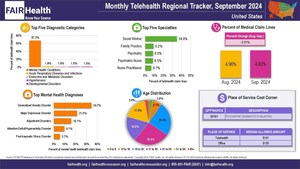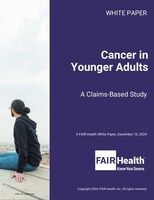FAIR Health Survey: Viewpoints about ER Use for Non-Emergency Care Vary Significantly by Race, Age, Education and Income
Millennials and Younger Gen-Xers Are More Likely to Rely on Urgent Care than Older Consumers
Consumers Aged 45+ More Likely to Depend on Primary Care
NEW YORK, May 6, 2015 /PRNewswire-USNewswire/ -- Latino consumers are nearly twice as likely as the general population to go to the emergency room (ER) for non-emergency care (39 percent vs. 21 percent) and a third of African-Americans said they would rely on the ER in the event of non-emergency care, according to a FAIR Health survey. The survey also showed significant differences along generational and socio-economic lines.
These disparities in consumer attitudes and practices come at a time when there is a national spotlight on reducing healthcare costs and increasing transparency. Consumers are also facing increased out-of-pocket costs as employers look for ways to control healthcare premiums with high-deductible plans. Where consumers go for care can significantly impact individual out-of-pocket and overall healthcare costs. The cost of visiting the emergency room for non-emergency care can be substantially higher than accessing care in other places of service, such as a physician's office or an urgent care center. In addition, accessing non-emergent care at the ER can often result in long wait times as true emergency care is prioritized.
The survey asked:
Q: In the event that you require treatment for a non-emergency or non-life threatening situation, where would you most likely go for care?
| Race/Ethnicity |
Emergency Room |
Primary Care |
Urgent Care |
Walk-in Clinic at |
| Black (Non-Latino) |
33% |
43% |
16% |
6% |
| Latino |
39% |
35% |
16% |
8% |
| White (Non-Latino) |
16% |
63% |
14% |
4% |
| Total Population |
21% |
55% |
15% |
5% |
"Helping underserved communities build solid healthcare literacy can potentially help to lower costs and remove some of the barriers to accessing care," said Robin Gelburd, president of FAIR Health. "Consumers who understand how the healthcare system works are empowered to make informed choices about the appropriate location of service for routine, urgent and emergency care."
FAIR Health offers free consumer healthcare literacy and cost estimation tools in English and Spanish at www.fairhealthconsumer.org or www.consumidor.fairhealth.org. Government agencies, employers, brokers, hospitals, medical facilities, doctors, insurers and consultants use FAIR Health data to power transparency tools and customize and brand educational materials, including online treatment cost calculators.
Generation, Income and Education
The survey also revealed significant differences along socio-economic and generational lines. While all age groups are most likely to visit a primary care facility in a non-emergency situation, consumers aged 45and older are more likely than younger adults to rely on primary care, whereas millennials (ages 18-34) and younger Gen Xers (ages 35-44) are significantly more likely than their older counterparts to visit an urgent care center. People without college education and with lower incomes were also more likely to rely on the ER for non-emergency care than those with higher incomes or some higher education.
The survey asked:
Q: In the event that you require treatment for a non-emergency or non-life threatening situation, where would you most likely go for care?
| Age |
Primary Care |
Emergency Room |
Urgent Care |
Walk-in Clinic at |
| 18-34 |
43% |
25% |
21% |
7% |
| 35-44 |
54% |
21% |
19% |
3% |
| 45-54 |
64% |
19% |
8% |
5% |
| 55-64 |
62% |
16% |
13% |
7% |
| 65+ |
59% |
22% |
9% |
4% |
| Total Population |
55% |
21% |
15% |
5% |
| Household Income |
Primary Care |
Emergency Room |
Urgent Care |
Walk-in Clinic |
| Less than 35K |
44% |
32% |
16% |
5% |
| 35 - 49.9K |
61% |
21% |
11% |
6% |
| 50- 74.9K |
62% |
15% |
13% |
6% |
| 75-99.9K |
76% |
8% |
11% |
5% |
| 100K or More |
70% |
5% |
18% |
3% |
| Total Population |
55% |
21% |
15% |
5% |
| Education |
Primary Care |
Emergency Room |
Urgent Care |
Walk-in Clinic |
| HS Graduate or Less |
48% |
31% |
14% |
4% |
| Some College |
59% |
19% |
14% |
5% |
| College Graduate |
63% |
10% |
17% |
7% |
| Total Population |
55% |
21% |
15% |
5% |
About FAIR Health
FAIR Health is a national, independent, nonprofit corporation dedicated to bringing transparency to healthcare costs and health insurance information through comprehensive data products and custom analytics, consumer resources and health systems research support. FAIR Health uses its database of billions of billed medical and dental services to power an award-winning free website. For more information, visit fairhealth.org.
About the Survey
FAIR Health's survey was conducted on March 5-8, 2015 by ORC International's Telephone CARAVAN®. The study was conducted using two probability samples: randomly selected landline and randomly selected mobile phone numbers. The combined sample consists of 1,011 adults in the U.S. The margin of error is +/- 3.08 percent at the 95 percent confidence level. The sum of the items in the tables may not equal 100% due to rounding, refusals or other non-response categories.
SOURCE FAIR Health
Related Links
WANT YOUR COMPANY'S NEWS FEATURED ON PRNEWSWIRE.COM?
Newsrooms &
Influencers
Digital Media
Outlets
Journalists
Opted In





Share this article